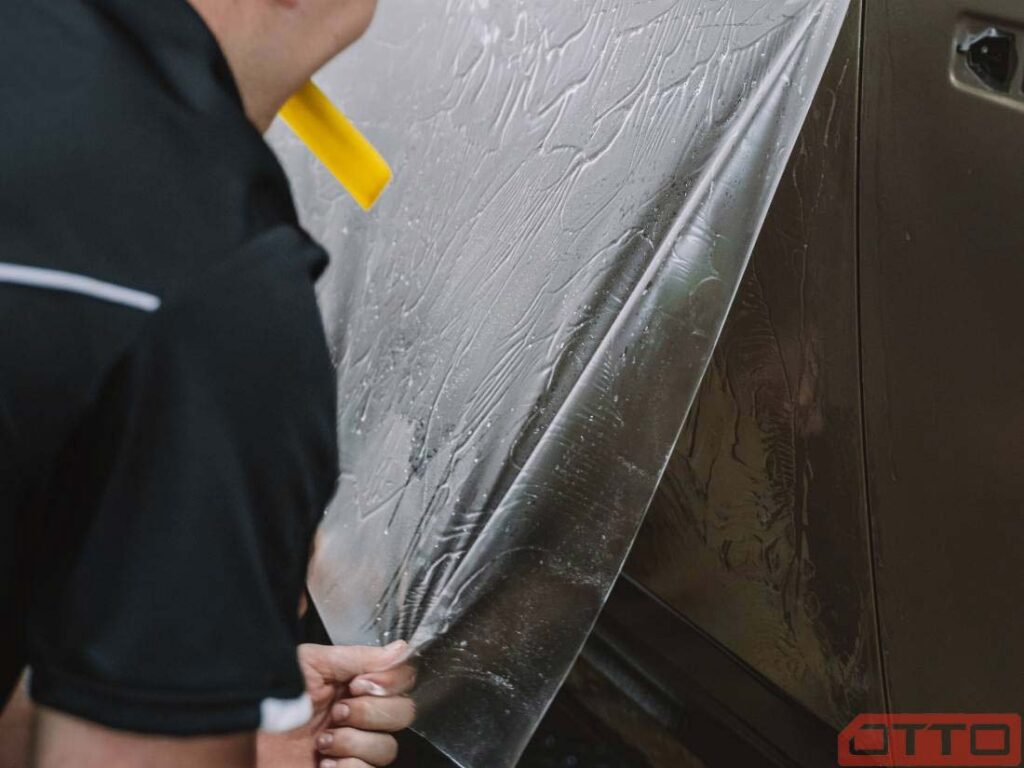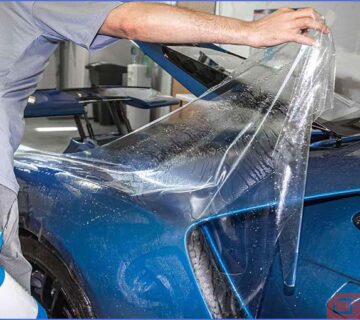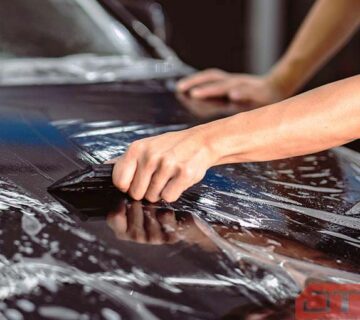Paint protection film is a relatively thick transparent layer of urethane that’s applied on top of the body panels to protect the paint underneath.
Urethane is a widely-used polymer throughout the automotive and practically every other industry. Modern cars have urethane bumpers, as well as urethane insulation, seals, and even interior components.
The material is very strong, flexible, chemically stable, and resistant to UV degradation.
Applied on top of your vehicle, it becomes a second skin to body panels, protecting the paint against mechanical damage like scratches, dings, and paint chips, as well as UV and chemical erosion.
Paint protection film was invented to protect helicopter rotor blades from flying shrapnel, debris, and dust during Vietnam. It worked very well and is still used today.

Race teams took notice in the 80s and realized that a transparent lightweight film could help protect race cars from the rocks, debris and rubber flying along the track, as well as contact during close-quarters driving.
Today, paint protection film is a 250-million-dollar market, protecting hundreds of thousands, if not millions of cars from daily grit.
How Does Paint Protection Film Work?
Paint protection film comes in rolls of ready-to-use material. It consists of several different layers, each with a different function.
On the bottom is a release liner that protects the other layers and keeps them clean up until installation. When it’s time to apply the film, the liner is removed and discarded.
In the middle is a layer of acrylic adhesive about 1.6 mils thick (0.040mm). The adhesive binds the PPF to the clear coat, but is designed to stick to remain attached to the film, making it 100% removable without damaging or permanently altering the paint.
The real work is done by the urethane layer, the thickest portion of the film at about 6 mils (0.152mm).
When a rock flies into the car, it will make contact with a jagged edge or point, focusing all of the impact energy into a very small area. Automotive paint is thin and not very flexible, so it will crack and eventually chip away.
A couple of years of driving will put dozens of these on anything exposed to the airstream – front bumper, fenders, hood, rocker panels, etc.
Once this happens, the paint is never going to be perfect again. You can touch up the chipped areas and reapply the clear coat, and with enough polishing, the paint will look great from any reasonable distance. However, after a certain amount, it’s more economical to repaint the entire panel, and that’s already expensive.
When you have PPF applied, the urethane layer will flex when impacted, absorbing some of the force and spreading out the rest onto a much wider area, thereby saving the paint.
Finally, modern PPF products feature a thin clear coat layer about 0.5 mils thick (0.013mm), which seals and protects the urethane layer from contaminants.
Urethane is porous on its own and, if exposed to the environment, will trap microscopic particles from the road, which will discolor the film over time. That’s why older or cheaper PPF products turn yellow after some years.
The top coat is resistant to UV, oxidation, and a variety of airborne chemicals and pollutants.
Self-Healing
Scratches, scuffs, and scrapes will accumulate in the film, but they won’t stay for long. Paint protection films have a self-healing property.
Urethane works similarly to a super-viscous liquid such as honey. Any pressure will cause it to buckle and deform, pushing the material away without forming tears and cuts.
Urethane is a thermoplastic polymer, which means it softens and becomes more malleable when heated. Applying heat to the film, it wants to reject the energy absorbed by the impact and return to a flat, uniform state.
It hardens back to its regular strength when it cools, and you can cycle it indefinitely without changing the chemical structure.
It’s almost magical when you see how scratches and scuffs disappear in seconds after blasting the film with a heat gun. Depending on where you live, on a hot sunny day, the film will sort itself out, healing most impact zones and straightening out.
Still, you want to be realistic about paint protection film. It will like an invincible material, but it has its limits. Obviously, if you take a knife through the film, you will tear it apart and cut into the paint, ruining the whole panel in an instant.
Larger impacts can also make a dent in the body panel. As long as they don’t tear through the film, the paint should be spared, but you’ll have to make a visit to the body shop to straighten it out.
Paint Protection Film vs. Clear Bra
These are the exact same thing.
Clear Bra was the name given to one of the first paint protection films developed for consumer use. The name comes from the “Car Bra”, a black vinyl cover used in the 1960s to protect vehicles from stone chips and other mechanical damage.
Paint protection films are also called Clear Wrap, Clear Mask, Stone Guard, and other names depending on where you live.




WASH YOUR CAR TWICE A MONTHNo matter how clean your car appears, make sure to clean it every other week.
By using Paint protection film, there is no need to wash a lot